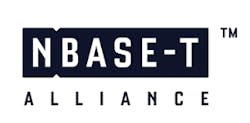NBASE-T Alliance technology optimization white paper explains 'NBASE-T Downshift'
A new white paper issued by the NBASE-T Alliance describes the new "NBASE-T Downshift" protocol, and how it optimizes transmission rates to get the highest achievable data rate out of installed Category 5e and Category 6 structured cabling. Authored by Cisco engineers Ken Naumann and Amrik Bains, the technical paper's thesis is that "NBASE-T Downshift augments the IEEE 802.3bz standard by providing a mechanism to select the best speed available within the constraints of the cabling."
The new white paper explains:
-- Challenges of operating at various speeds overinstalled structured cabling due to frequency limitations and noise;
-- Types of noise conditions that can impact achievable link speed;
-- IEEE 802.3bz Auto-Negotiation;
-- How "NBASE-T Downshift" overcomes auto-negotiation’s limitations.
The paper's introduction is as follows:
"The NBASE-T Physical Layer Specification version 2.3, and the IEEE 802.3bz standard, specify operation of 2.5Gb/s and 5Gb/s Ethernet over Category 5e or Category 6 (or better) structured cabling, applying sophisticated signaling techniques to exceed the 1Gb/s rate for which this cabling was originally designed.
In the vast majority of cases, the technology is designed to deliver multigigabit speeds without any special considerations from the user. In some cases, however, the quality of the cable, how cables are bundled together, or “alien noise” (interference from sources external to the cable) affects the ability of a network link to reach these higher speeds.
When a network node (e.g., a PC or a Wi-Fi access point) turns on, it automatically negotiates with the node at the opposite end of the cable, (e.g., an Ethernet switch) the fastest rate at which both nodes can operate. If the cabling environment is impaired such that operating at the highest negotitated speed may generate packet errors beyond the limit specified in the standard, the nodes will suspend communication (Link Down) and then repeat the Auto-Negotiation process.
If the nodes once more negotiate operation at the same highest advertised speed, errors may once again force the link to be down. Historically, only manual configuration of the network to force a lower speed, less susceptible to errors, could get the link out of this persistent link flap state.
With NBASE-T Downshift, the best available data rate is selected for the connected link. Downshift works for 10Gb/s and other rates in addition to 2.5Gb/s and 5Gb/s. Downshift enables a link that fails to automatically renegotiate (with no manual re-configuration required via a management interface) to a lower link speed using the IEEE 802.3bz standard Auto-Negotiation mechanism. NBASE-T Downshift enhances the user experience by smoothly reducing link rates, avoiding persistent Link Down."
View/Download Full White Paper (PDF): NBASE-T Downshift: Optimization of 2.5Gb/s and 5Gb/s Ethernet Data Rates Over Cat5e/Cat6 Cabling
